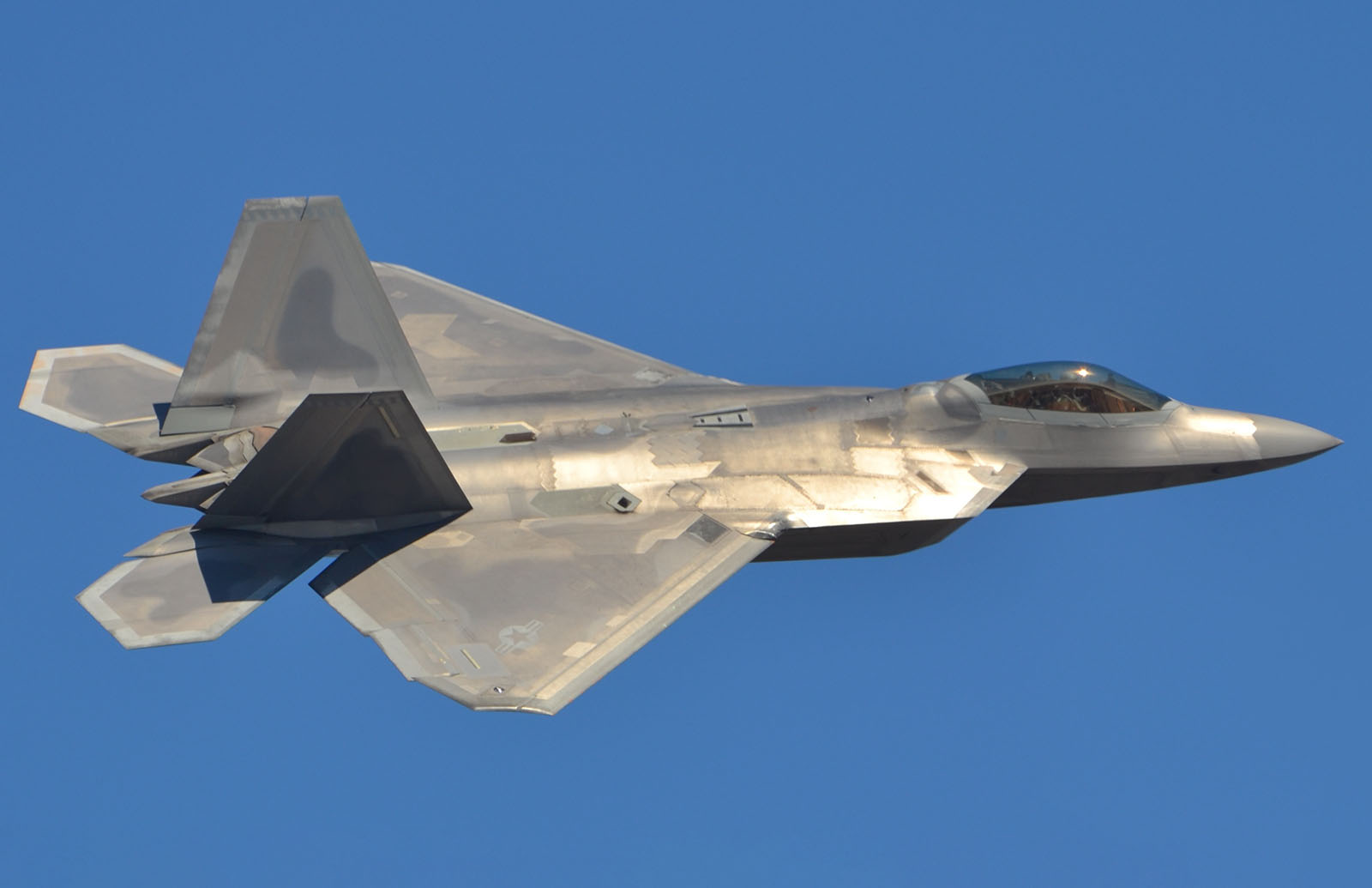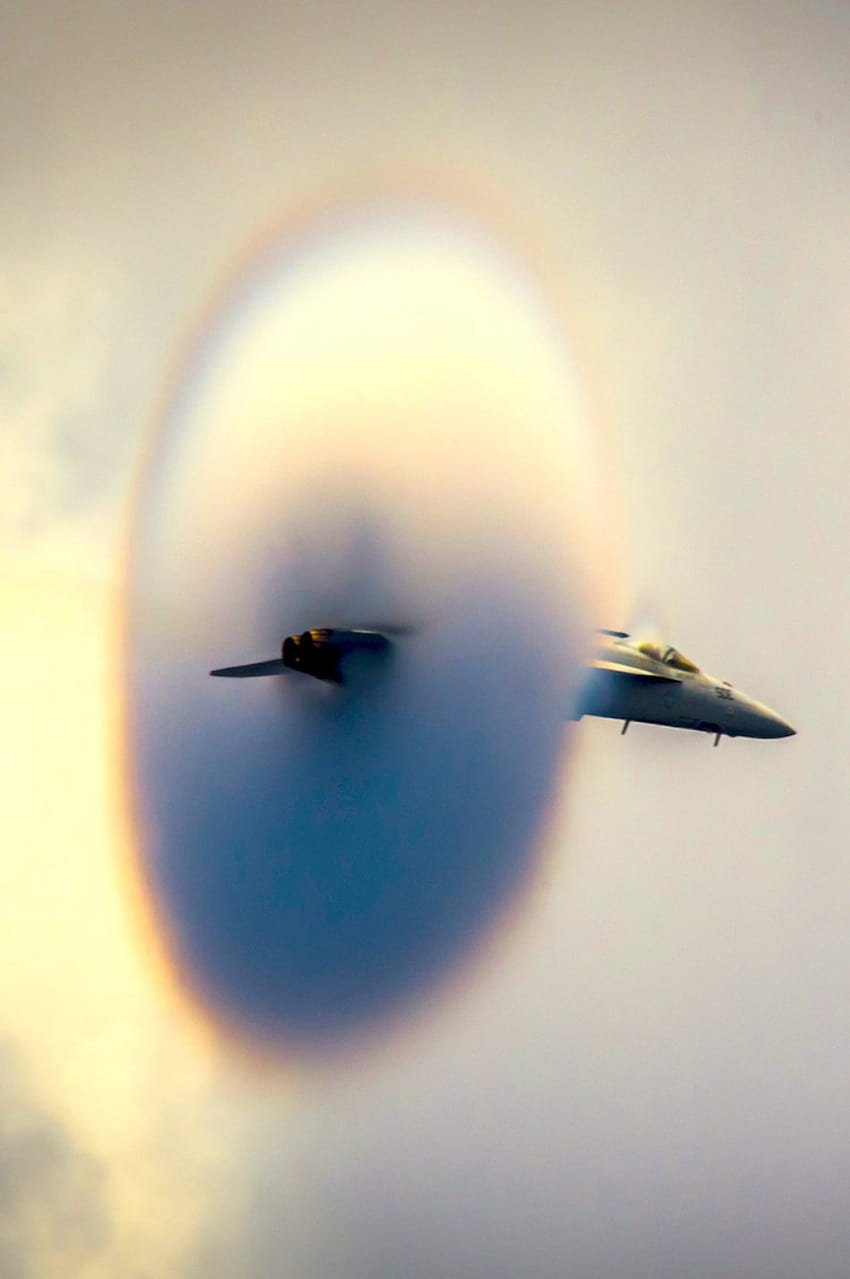Fighter Jet Breaking Sound Barrier - A US Navy F/A-18 transonic aircraft breaks through the sound barrier. A white supersonic cloud is caused by a drop in air pressure and temperature in the tail of an aircraft (see Prandtl-Glauert characteristic).
Sound reduction or sound barrier is the large increase in aerodynamic drag and other adverse effects of an aircraft or other object as it approaches the speed of sound. When aircraft first approached the speed of sound, these effects became a barrier, making higher speeds very difficult or impossible.
Fighter Jet Breaking Sound Barrier

The term sonic barrier is still used today to refer to aircraft approaching supersonic flight in this high drag mode. Supersonic flight creates a sonic boom.
Breaking The Sound Barrier In A F 16d Fighting Falcon Fighter Jet
In dry air at 20 °C (68 °F), the speed of sound is 343 meters per second (about 767 miles, 1,234 km/h or 1,125 ft/s). The term came into use during World War II, when pilots of high-speed fighter jets experienced compression effect, a series of adverse aerodynamic effects that inhibit further acceleration, which seem to prevent them from flying at close speeds of the speed of sound. These difficulties prevented high-speed flight. In 1947, American test pilot Chuck Yeager demonstrated that safe supersonic flight could be achieved with specially designed aircraft, breaking the barrier. In the 1950s, new fighter jet designs were usually supersonic and faster.
Some simple whips, such as a bull or whip, can travel faster than sound: the tip of the whip exceeds this speed and creates a sharp crack - literally a sonic boom.
The sound barrier may have been first broken by creatures 150 million years ago. Some paleobiologists report that computer models of their biomechanical capabilities show that some long-tailed dinosaurs, such as Brontosaurus, Apatosaurus, and Diplodocus, could swing their tails at supersonic speeds to produce a cracking sound. This finding is theoretical and contested by others in the field.
Meteorites in Earth's upper atmosphere typically travel faster than Earth's escape velocity, which is much faster than sound.
Air Force Scrambles Two F 15's
The peak speed of the propeller blades depends on the speed of the propeller and the forward speed of the aircraft. If the speed of the plane is high, the tips will reach supersonic speed. Shock waves form at the tips of the blades and reduce how much of the shaft power that drives the propeller is converted into the force needed to propel the aircraft. For faster flight, the gina power required to compensate for this loss, as well as to balance the increase in aircraft speed, is so great that the gina size and weight are prohibitive. This speed limitation led to research on jet engines, notably by Frank Whittle in England and Hans von Ohein in Germany. Jet gin is good for two reasons. It produces the required pulling power from a relatively small size compared to the piston hydra it replaced. The rotating vanes at the front of the jet hydra are not adversely affected by the high speed of the aircraft like a propeller.
However, propeller-driven aircraft were able to approach a critical Mach number during a dive, which was different for each aircraft. Unfortunately, this has led to many accidents for various reasons. Flying the Mitsubishi Zero, the pilots sometimes flew at full power on the ground because the rapidly increasing forces acting on the aircraft's control surfaces overwhelmed them.
In this case, multiple attempts to fix it only make the problem worse. Similarly, the bending caused by the low torsional stiffness of the Supermarine Spitfire's wings made them in turn resist aileron control inputs, leading to what is known as control roll. This was fixed in later models with wing modifications. To make matters worse, Lockheed P-38 Lightnings had particularly dangerous airflow interactions between the wing and tail surfaces of the diver, making it difficult for divers to "exit"; however, the problem was later solved by adding a "dive flap" that cut off the airflow in these cases. Vibration caused by shock waves on curved surfaces was another major problem, leading to the crash of the famous de Havilland Swallow and the death of its pilot, Geoffrey de Havilland, on 27 September 1946. A similar problem caused the crash of the BI-1 rocket plane in Soviet Union in 1943.

All of these effects, although unrelated, led to the concept of "drag", making it difficult for an aircraft to exceed the speed of sound.
Breaking Sound Barrier. Supersonic Fighter Jet Breaking Sound Barrier. Profile Of The Jet Fighter. Mach 1 Moment. 3d Render Illu Stock Photo
The erroneous news led most people to see the sound barrier as a physical "wall" that a supersonic aircraft had to "break" with the sharp tip of the needle at the front of the fuselage. The products of missile and artillery specialists routinely exceeded Mach 1, but aircraft designers and aerodynamicists discussed exceeding 0.7 as a dangerous limit during and after World War II.
During and immediately after World War II, there were a number of claims that the sound barrier had been broken by diving. Most of these alleged errors can be dismissed as manual errors. A conventional airspeed indicator (ASI) uses the difference in air pressure between two or more points on the aircraft, usually near the nose and on the side of the fuselage, to generate a speed reading. Various compression effects that result in audio blocking at high speeds also result in inaccurate or low readings, depending on the ASI's non-linearity and the particulars of the installation. This effect was called "Jump to Match".
Before the introduction of machmeters, accurate measurements of supersonic speeds could only be made from a distance, usually using ground-based instruments. Many claims of supersonic speeds have been proven to be much lower than this speed measured by this method.
In 1942, the Republican Air Force issued a press release titled Lt. Lt. Harold E. Comstock and Roger Ready Exceed the Speed of Sound During a Test Dive in the Republic P-47 Lightning. It is widely agreed that this is due to inaccurate ASI readings. In similar tests, the North American P-51 Mustang showed a limit of Mach 0.85, and any flight above Mach 0.84 resulted in vibration damage to the aircraft.
Comeback Kid: The Next Sound Barrier Busting Passenger Jet Could Be Quietly Supersonic
The Spitfire PR Mk XI (PL965) was used in the 1944 RAE Farnborough dive tests, during which a maximum Mach number of 0.92 was achieved.
One of the highest recorded instrument Mach numbers for an aircraft is Mach 0.891 for a Spitfire PR XI flown during dive trials at the Royal Aircraft Establishment, Farnborough, in April 1944. Spitfire, photo reconnaissance version, Mark XI. The aircraft, equipped with an extended "rake-type" multi-pitot system, was flown by Squadron Leader J.R. Tobin flew at this speed, which corresponds to a true airspeed (TAS) of 606 mph.
On a subsequent flight, Squadron Leader Anthony Martindale achieved a Mach of 0.92, but crashed during a forced landing after damaging the engine from excessive spin.

Hans Guido Mutke claimed to have broken the sound barrier in a Messerschmitt Me 262 jet on April 9, 1945. He said his ASI was set at 1,100 kilometers (680 miles) per hour. Mutke reported that not only did the transonic noise occur, but that once a certain speed was exceeded, normal control was restored and that the loud noise resumed when the Me 262 slowed down again. He also reported burning a hydra.
Nasa Poised To Break Sound Barrier In New Way
All the effects they report are known to occur at much lower speeds in the Me 262, and the ASI reading is not reliable in transonic. Furthermore, a series of tests conducted by Carl Doetsch under Willy Messerschmitt found that the aircraft was uncontrollable above Mach 0.86 and would enter an unrecoverable dive at Mach 0.9. Post-war RAF tests confirmed these results, using the new instruments, finding the maximum speed to be Mach 0.84 rather than Mach 0.86.
In 1999, Mutke, with the help of Otto Wagner, a professor at the Technical University of Munich, helped conduct computational tests to determine whether an airplane could break the sound barrier. These tests do not rule out the possibility, but there is no accurate drag coefficient data that would be needed to make an accurate simulation.
"I don't want to rule it out, but I can imagine it was a little bit below the speed of sound and felt the impact, but not over Mach-1," Wagner said.
Part of the evidence presented by Muthke is on page 13 of the "Me 262 A-1 Pilot's Manual" issued on 10 January 1946 by Headquarters, Wright Field, Wright Field, Ohio, under report no. F-SU-1111-ND:
Does A Video Show A Fighter Jet Breaking The Sound Barrier?
A speed of 950 km/h (590 mph) was reportedly achieved in a shallow dip of 20° to 30° horizontal. No vertical dives were made. At speeds between 950 and 1,000 km/h (590 and 620 mph), the airflow around the aircraft reaches the speed of sound and it is reported that the control surfaces no longer affect the direction of flight. Results will vary depending on the aircraft: some will flap their wings and dive, while others will dive
A jet breaking the sound barrier, fighter jet sound barrier, photo of jet breaking sound barrier, jet breaking sound barrier, jet plane breaking the sound barrier, picture of jet breaking sound barrier, video of jet breaking sound barrier, fighter jet breaking the sound barrier, navy jet breaking sound barrier, jet fighter breaking sound barrier, fighter jets breaking sound barrier, jet plane breaking sound barrier
0 Comments